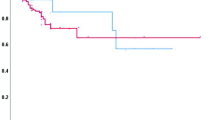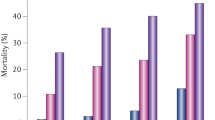Abstract
Background: Thrombolytic therapy has been shown to reduce mortality in select patients with acute myocardial infarction (AMI). The determinants of eligibility for therapy are changing as more information about the safety and efficacy of thrombolytic therapy is obtained. In the United States, there is some concern that thrombolytic therapy is underutilized, particularly in women and older patients. The purpose of this investigation is to examine change in the use of thrombolytic therapy in a single community from the years 1988 to 1992. Particular attention was paid to women and older patients.Methods: From January 1988 through December 1992, 9154 patients who developed AMI were admitted to coronary care units in 19 hospitals in the metropolitan Seattle area. The hospital records of each consecutive patient were reviewed, and key information was entered into the Myocardial Infarction Triage and Intervention database. Patients who developed AMI after hospital admission for another medical condition were excluded, as were the small numbers of patients with AMI complicated by cardiac arrest and resuscitation prior to hospital admission. This population-based study contains first admissions for AMI during the 5 year period of the registry.Results The use of thrombolytic therapy in all patients increased from 18% to 24% (p <.0001) during the 5 year period; women (10–16%) and patients 75 years and older (3–10%) had proportionately greater increases in utilization. Despite widespread awareness of its importance, the median time from symptom onset to hospital arrival did not change during the 5 years, although there was a slight decrease in the time from hospital arrival to treatment with thrombolytic therapy.Conclusions: The change in use of thrombolytic therapy indicates that age and gender are less often used as exclusions for receiving thrombolytic therapy. It is possible that exclusionary criteria are being modified, with the result that this important treatment is being received by more people. The finding that there was no change in the time from acute symptom onset to hospital arrival requires intensive study. In particular, more needs to be known about patient decisionmaking, and innovative community interventions to reduce delay times must be evaluated.
Similar content being viewed by others
References
Gruppo Italiano per lo Studio della Streptochinasi Miocardio (GISSI). Effectiveness of intravenous thrombolytic treatment in AMI.Lancet 1986;I:397–402.
Gruppo Italiano per lo Studio della Streptochinasi Miocardio (GISSI). GISSI-2: A factorial randomized trial of alteplase versus streptokinase and heparin versus no heparin among 12,490 patients with acute myocardial infarction.Lancet 1990;336:65–71.
ISIS-2 (Second International Study of Infarct Survival) Collaborative Group. Randomised trial of intravenous streptokinase, oral aspirin, both, or neither among 17,187 cases of suspected acute myocardial infarction: ISIS 2.Lancet 1988;2:349–360.
ISIS-3 (Third International Study of Infarct Survival) Collaborative Group. ISIS-3: A randomised trial of streptokinase vs. tissue plasminogen activator vs. anistreplase and of heparin vs. aspirin alone among 41,299 cases of suspected acute myocardial infarction.Lancet 1992;339:753–770.
The GUSTO Investigators. An international randomized trial comparing four thrombolytic strategies for acute myocardial infarction.N Engl J Med 1993;329:673–682.
Gurwitz JH, Col NF, Avorn J. The exclusion of the elderly and women from clinical trials in acute myocardial infarction.JAMA 1992;268:1417–1422.
Pfeffer MA, Moye LA, Braunwald E, et al. for The SAVE Investigators. Selection bias in the use of thrombolytic therapy in acute myocardial infarction.JAMA 1991;266:528–532.
Fibrinolytic Therapy Trialists' Collaborative Group. Indications for fibrinolytic therapy in suspected acute myocardial infarction: Collaborative overview of early mortality and major morbidity results from all randomized trials of more than 1000 patients.Lancet 1994;343:311–322.
Weaver WD, Eisenberg MS, Martin JS, et al. Myocardial infarction triage and intervention project-phase I: Patient characteristics and feasibility of prehospital initiation of thrombolytic therapy.J Am Coll Cardiol 1990;15:925–931.
Maynard C, Litwin PE, Martin JS, Weaver WD. Treatment and outcome of acute myocardial infarction in women 75 years and older.Cardiol Elderly 1993;1:121–125.
Krumholz HM, Pasternak RC, Weinstein MC, Freisenger GC, Ridker PM, Tosteson ANA. Cost effectiveness of thrombolytic therapy with streptokinase in elderly patients with suspected acute myocardial infarction.N Engl J Med 1992;327:7–13.
Topol EJ, Califf RM. Thrombolytic therapy for elderly patients.N Engl J Med 1992;327:45–47.
Ho MT, Eisenberg MS, Litwin PE, Schaeffer SM, Damon SK. Delay between onset of chest pain and seeking medical care: The effect of public education.Ann Emerg Med 1989;18:727–731.
Herlitz J, Hartford M, Blohm M, et al. Effect of a media campaign on delay times and ambulance use in suspected acute myocardial infarction.Am J Cardiol 1989;64:90–93.
Mitic WR, Perkins J. The effect of a medical campaign on heart attack delay and duration time.Can J Public Health 1984;75:414–418.
Maynard C, Althouse R, Olsufka M, Ritchie JL, Davis KB, Kennedy JW. Early versus late hospital arrival for acute myocardial infarction in the Western Washington thrombolytic therapy trials.Am J Cardiol 1989;63:1296–1300.
Dracup K, Moser DK. Treatment-seeking behavior among those with signs and symptoms of acute myocardial infarction.Heart Lung 1991;20:570–575.
Martin JS, Kudenchuk PJ, Litwin PE, for The MITI Project Investigators. Do pre-hospital electrocardiograms affect treatment incidence, time to treatment, and hospital admission rates for acute myocardial infarction (abstr)?Circulation 1993;88:I-17.
Martin JS, Smith DD, Kline EM. Factors associated with in-hospital delay to treatment with thrombolytic therapy in acute myocardial infarction (abstr).Circulation 1993;88:I-17.
Doorey AJ, Michelson EL, Topol EJ. Thrombolytic therapy of acute myocardial infarction: Keeping the unfulfilled promises.JAMA 1992;268:3108–3114.
Author information
Authors and Affiliations
Additional information
Supported by grant #R01 H138454 from the National Heart Lung and Blood Institute, Bethesda, Maryland, and by an unrestricted grant from Genentech, Inc., South San Francisco, California.
Rights and permissions
About this article
Cite this article
Maynard, C., Martin, J.S., Hallstrom, A.P. et al. Changes in the use of thrombolytic therapy in Seattle area hospitals from 1988 to 1992: Results from the myocardial infarction triage and intervention registry. J Thromb Thrombol 1, 195–199 (1995). https://doi.org/10.1007/BF01062578
Received:
Accepted:
Issue Date:
DOI: https://doi.org/10.1007/BF01062578




